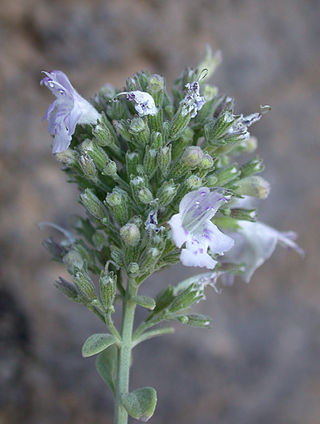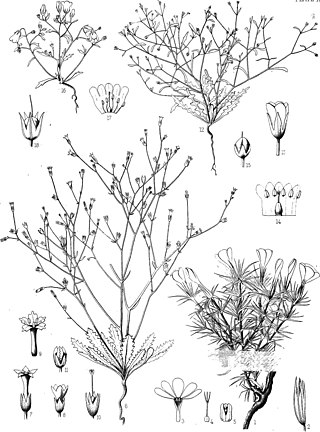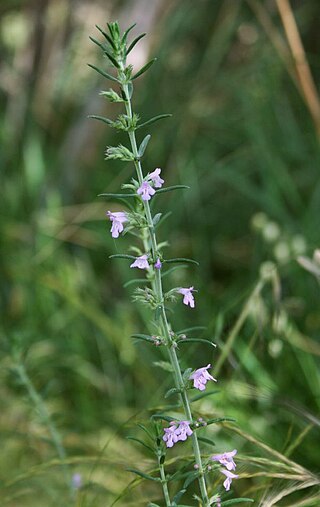
Micromeria douglasii, synonym Clinopodium douglasii, or yerba buena, is a rambling aromatic herb of western and northwestern North America, ranging from maritime Alaska southwards to California. The plant takes the form of a sprawling, mat-forming perennial, and is especially abundant close to the coast. The name "yerba buena" derives from Spanish for "good herb" and is applied to various other plants. In 2010, molecular evidence placed the species within the Clinopodium complex rather than Micromeria.
Micromeria remota is a species of flowering plant in the family Lamiaceae. It is found only in Yemen. Its natural habitats are subtropical or tropical dry forests and rocky areas.

Micromeria is a genus of flowering plants in the mint family, Lamiaceae, widespread across Europe, Asia, Africa, and North America, with a center of diversity in the Mediterranean region and the Canary Islands. It is sometimes placed within the genus Satureja. The name is derived from the Greek words μῑκρος (mīkros), meaning "small," and μερίς (meris), meaning "portion," referring to the leaves and flowers. Common names include savory and whitweed.

Micromeria fruticosa, commonly known as white micromeria or white-leaved savory, is a dwarf evergreen shrub endemic to the eastern Mediterranean, as well as found in the Balkans. It is a member of the genus Micromeria, in the family Lamiaceae. It is known as zuta levana in today's Modern Hebrew and ashab a-shai in Arabic. The Bedouins, however, call it by the Arabic name, qurniyya, believed to be a cognate of the Hebrew qoranit, an aromatic herb described in the Mishnah. The plant's aromatic leaves are used in making decoctions.

Aliciella micromeria is a species of flowering plant in the phlox family known by the common name dainty gilia. It is native to the western United States, especially the Great Basin. It is a small herb producing a thin, branching stem up to about 14 centimeters tall. It is coated thinly in soft hairs. Several deeply lobed leaves 1 to 6 centimeters long are located in a basal rosette at ground level around the stem. There are smaller, unlobed leaves along the stem. The inflorescence produces white or lavender flowers each about 3 millimeters wide.

Trifurcula is a genus of moths of the family Nepticulidae. For the Triassic aged ray-fin "Glaucolepis" Stensiö, 1921 see Pteronisculus.
Trifurcula eurema is a moth of the family Nepticulidae. It is widespread throughout Europe, northwards to southern Norway and Sweden, Poland and the Baltic Region. It is also found in the Mediterranean region, including the larger Mediterranean islands, east to Bulgaria, Asiatic Turkey and Ukraine.
Trifurcula manygoza is a moth of the family Nepticulidae. It is only known to be from Croatia and north-western Greece. But is probably also present in other Balkan countries.
Trifurcula ortneri is a moth of the family Nepticulidae. It is widespread in the western Mediterranean region, where it is known from the Algarve in Portugal, Spain, France and Italy. It has also been recorded from Croatia (Dalmatia), Morocco and Algeria, eastern Austria, Hungary, Slovakia and Germany.
Trifurcula hamirella is a moth of the family Nepticulidae. It is found in the Mediterranean region from the Iberian Peninsula to Greece and in Algeria.
Trifurcula pallidella is a moth of the family Nepticulidae. It is the type species of the genus Trifurcula. It is found from south-eastern Germany (Bayern), east into Bohemia, Moravia, Slovakia, adjacent south-eastern Poland, much of Austria, both along the Danube and east and south of the Alps, extending through the Balkans to southern Greece (Peloponnesus) and Crete, eastwards through Ukraine and Russia to the Volga, and one questionable record from Turkey. To the west it occurs in northern Italy almost reaching France, just extending into Switzerland (Ticino), and throughout Italy to Sicily and Corsica.
Trifurcula austriaca is a moth of the family Nepticulidae. It is found in Austria, the Czech Republic and Slovakia. It has also been reported from Greece.

Trifurcula subnitidella is a moth of the family Nepticulidae. It is widespread in Europe southward to the northern border of the Sahara in Tunisia and eastward to the Crimea and Asia minor.
Coleophora micromeriae is a moth of the family Coleophoridae. It is found in the Canary Islands.

Yerba buena or hierba buena is the Spanish name for a number of aromatic plants, most of which belong to the mint family. Yerba buena translates as "good herb". The specific plant species regarded as yerba buena varies from region to region, depending on what grows wild in the surrounding landscape, or which species is customarily grown in local gardens. Perhaps the most common variation of this plant is spearmint. The term has been used to cover a number of aromatic true mints and mint relatives of the genera Clinopodium, Satureja or Micromeria. All plants so named are associated with medicinal properties, and some have culinary value as herbal teas or seasonings as well.

Pierre Chrétien was a French entomologist who specialised in Lepidoptera. He was a member of Société entomologique de France. Trifurcula chretieniZ. & A. Lastuvka & van Nieukerken, 2013 is "named in honour of Pierre Chrétien (1846–1934), who discovered nepticulid mines on Bupleurum, including those on Bupleurum rigidum, and the first author to describe a number of Mediterranean species that are now placed in Trifurcula (Glaucolepis)." His collection is held by National Museum of Natural History in Paris.
Micromeria forbesii is a species of flowering plants of the genus Micromeria. The species is endemic to Cape Verde. It is listed as endangered by the IUCN. It was first described by George Bentham in 1834. Its local name is erva-cidreira, or cidreirinha. In traditional medicine, it is used as an infusion for the treatment of indigestion, diarrhea, cough and to stimulate labour.

Mentheae is the largest tribe of plants in the family Lamiaceae. It includes herbs such as sage, hyssop, mint, bee balm and thyme.

Micromeria graeca is a plant species in the family Lamiaceae.
Micromeria microphylla is a species of plants in the family Lamiaceae.








